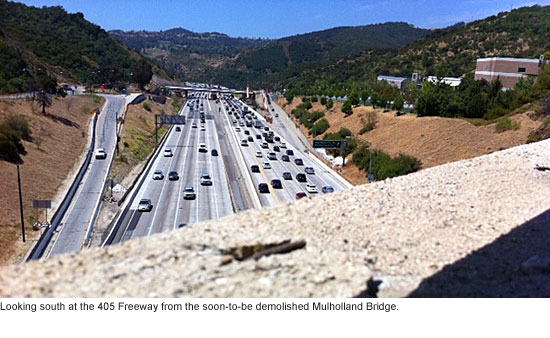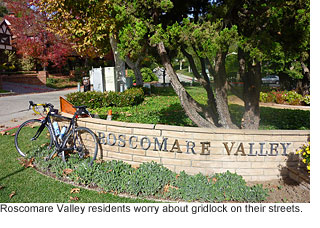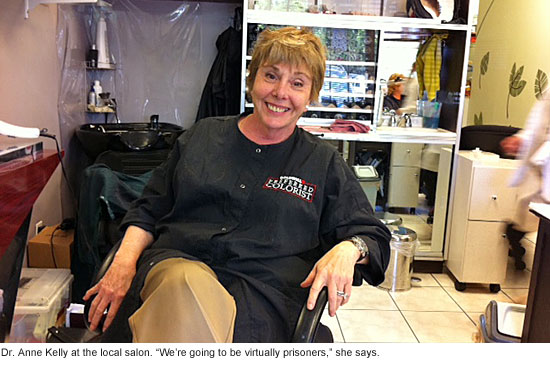Where L.A.’s lost weekend hits home
June 2, 2011
 In neighborhoods all around the 405 Freeway, people are scrambling to find answers to the biggest question of the summer: To get out of town, or to hunker down?
In neighborhoods all around the 405 Freeway, people are scrambling to find answers to the biggest question of the summer: To get out of town, or to hunker down?
“I’m terrified. I have company coming from out of town. What are we going to do?” said Dr. Anne Kelly as she waited to have her hair done at a local salon this week.
“We’re going to be virtually prisoners,” said Kelly, a psychologist who’s lived in the Roscomare Valley neighborhood on the east side of the freeway for 40 years. “I understand that things have to be done, but boy oh boy.”
When it was suggested that her professional services may be in demand, she joked: “I think you’re going to need a psychiatrist to dispense medication to deal with all the road rage.”
Yes, when you close one of the world’s busiest freeways for 53 straight hours, emotions run high—and people run scared. That goes double for folks in neighborhoods near the Mulholland Bridge, which is being demolished and rebuilt to make way for a 10-mile northbound carpool lane on the 405.
After a couple of hours of prep work that starts before midnight on Friday, July 15, the entire freeway will be closed all day Saturday, July 16, and Sunday, July 17, reopening at 5 a.m. Monday, July 18. The closure will stretch north from the 10 Freeway all the way to the 101, and south from the 101 to Getty Center Drive. Even with the official mantra of “Plan Ahead, Avoid The Area, Or Stay Home,” there are concerns in the community that huge numbers of motorists will have to be diverted onto their streets, causing gridlock and placing locals under virtual house arrest.
Already, a spirit of resignation is taking hold in Roscomare Valley, on the west side of Bel-Air, as some neighbors get ready to take cocooning to a whole new level.
“As a joke, I said let’s get enough food in for the weekend and not go out. I think it’ll be awful getting out of town,” said Belinda Broughton, a violinist having lunch with her son, Oliver Britten, at the tiny Sugar Cube café.
The same goes for Paul Gamberg, who represents the Roscomare Valley as an alternate on the freeway project’s community advisory committee.
“We’re planning to be landlocked and to swim a lot. We’ll provision up. I don’t think we’ll have a hard time getting to Whole Foods, but we might,” said Gamberg, who oversees a Yahoo message group that serves as a sounding board among neighbors concerned about the project.
“I get emails all the time from people who are up in arms,” he said. “There’s been a lot of fury.”
A lot of it is apprehension about the “hellish” 53-hour freeway closure. But what really has him on edge is what happens afterward—when routes through the “desirable, paradisiacal neighborhood” become clogged and increased traffic worsens the condition of local roadways.
“We’re the first canyon east of the 405,” he said. “The reason our road is closed to through traffic is because it’s a narrow street and the city can ill afford to keep up with the potholes as it is.”
While some are getting ready to tough it out at home, others are making plans to hit the road.
“We’re getting out of here! We’re going to go camping,” said Joko Tamura, who’s also had to reschedule her son’s 11th birthday party from July 16—the actual date—to July 9. (And Tamura’s not the only one to take a red pencil to the calendar; weddings, religious services and museum exhibitions in the area also have been shuttered, moved or postponed.)
Amid all the apprehension, there are those in the neighborhood who feel that the 53-hour closure will just be one more chapter in the long and difficult saga of the $1.034 billion I-405 Sepulveda Pass widening project.
“The street is just awful. Getting to the 405 used to be 5 minutes; now it’s much longer. And Sunset is just unbearable,” said Karen Klaustermeyer, who moved to the Roscomare area in 1971. “It’s just tearing up everything. The city of L.A. should look at the deterioration…I think they’ve forgotten about us.”
For those closest to the action, the best survival strategy for getting through the weekend-long freeway closure will be acceptance—and a positive attitude, said Robert Ringler, president of the Bel-Air Beverly Crest Neighborhood Council and a chair of the LAPD’s West Bureau Traffic Committee. “Screaming and yelling is fruitless,” he said. “Attitude—it’s so important. Attitude and planning.”
Posted 6/2/11












 405 bridge work causes a stink
405 bridge work causes a stink

